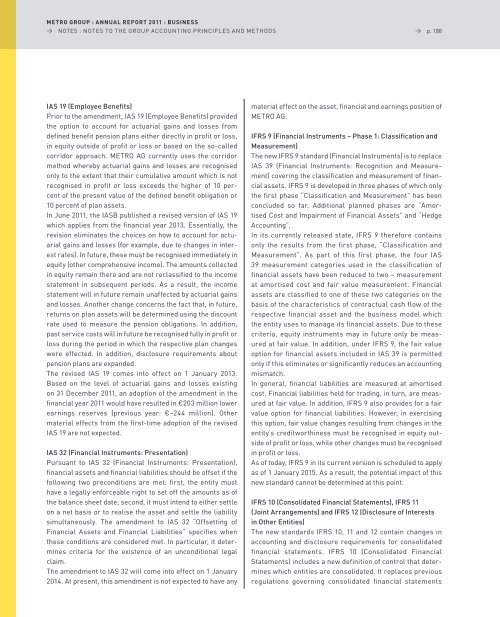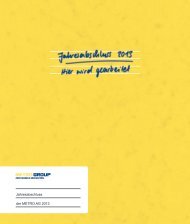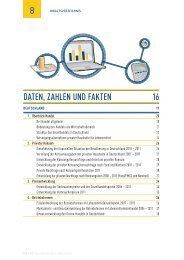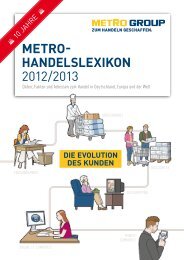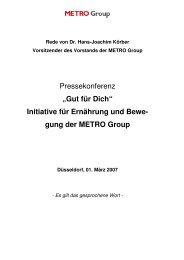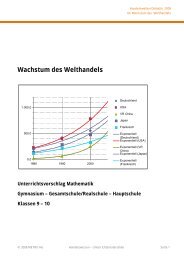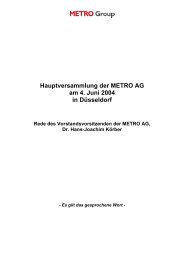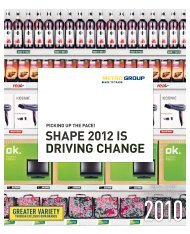pdf (22.8 MB) - METRO Group
pdf (22.8 MB) - METRO Group
pdf (22.8 MB) - METRO Group
Create successful ePaper yourself
Turn your PDF publications into a flip-book with our unique Google optimized e-Paper software.
<strong>METRO</strong> gROUP : ANNUAL REPORT 2011 : BUsiNEss<br />
→ noTes : noTes To THe GRoUp aCCoUnTInG pRInCIples anD MeTHoDs<br />
IAS 19 (Employee Benefits)<br />
prior to the amendment, Ias 19 (employee Benefits) provided<br />
the option to account for actuarial gains and losses from<br />
defined benefit pension plans either directly in profit or loss,<br />
in equity outside of profit or loss or based on the so-called<br />
corridor approach. MeTRo aG currently uses the corridor<br />
method whereby actuarial gains and losses are recognised<br />
only to the extent that their cumulative amount which is not<br />
recognised in profit or loss exceeds the higher of 10 percent<br />
of the present value of the defined benefit obligation or<br />
10 percent of plan assets.<br />
In June 2011, the IasB published a revised version of Ias 19<br />
which applies from the financial year 2013. essentially, the<br />
revision eliminates the choices on how to account for actuarial<br />
gains and losses (for example, due to changes in interest<br />
rates). In future, these must be recognised immediately in<br />
equity (other comprehensive income). The amounts collected<br />
in equity remain there and are not reclassified to the income<br />
statement in subsequent periods. as a result, the income<br />
statement will in future remain unaffected by actuarial gains<br />
and losses. another change concerns the fact that, in future,<br />
returns on plan assets will be determined using the discount<br />
rate used to measure the pension obligations. In addition,<br />
past service costs will in future be recognised fully in profit or<br />
loss during the period in which the respective plan changes<br />
were effected. In addition, disclosure requirements about<br />
pension plans are expanded.<br />
The revised Ias 19 comes into effect on 1 January 2013.<br />
Based on the level of actuarial gains and losses existing<br />
on 31 December 2011, an adoption of the amendment in the<br />
financial year 2011 would have resulted in €203 million lower<br />
earnings reserves (previous year: €–244 million). other<br />
material effects from the first-time adoption of the revised<br />
Ias 19 are not expected.<br />
IAS 32 (Financial Instruments: Presentation)<br />
pursuant to Ias 32 (Financial Instruments: presentation),<br />
financial assets and financial liabilities should be offset if the<br />
following two preconditions are met: first, the entity must<br />
have a legally enforceable right to set off the amounts as of<br />
the balance sheet date; second, it must intend to either settle<br />
on a net basis or to realise the asset and settle the liability<br />
simultaneously. The amendment to Ias 32 “offsetting of<br />
Financial assets and Financial liabilities” specifies when<br />
these conditions are considered met. In particular, it determines<br />
criteria for the existence of an unconditional legal<br />
claim.<br />
The amendment to Ias 32 will come into effect on 1 January<br />
2014. at present, this amendment is not expected to have any<br />
→ p. 188<br />
material effect on the asset, financial and earnings position of<br />
MeTRo aG.<br />
IFRS 9 (Financial Instruments – Phase 1: Classification and<br />
Measurement)<br />
The new IFRs 9 standard (Financial Instruments) is to replace<br />
Ias 39 (Financial Instruments: Recognition and Measurement)<br />
covering the classification and measurement of financial<br />
assets. IFRs 9 is developed in three phases of which only<br />
the first phase “Classification and Measurement” has been<br />
concluded so far. additional planned phases are “amortised<br />
Cost and Impairment of Financial assets” and “Hedge<br />
accounting”.<br />
In its currently released state, IFRs 9 therefore contains<br />
only the results from the first phase, “Classification and<br />
Measurement”. as part of this first phase, the four Ias<br />
39 measurement categories used in the classification of<br />
financial assets have been reduced to two – measurement<br />
at amortised cost and fair value measurement. Financial<br />
assets are classified to one of these two categories on the<br />
basis of the characteristics of contractual cash flow of the<br />
respective financial asset and the business model which<br />
the entity uses to manage its financial assets. Due to these<br />
criteria, equity instruments may in future only be measured<br />
at fair value. In addition, under IFRs 9, the fair value<br />
option for financial assets included in Ias 39 is permitted<br />
only if this eliminates or significantly reduces an accounting<br />
mismatch.<br />
In general, financial liabilities are measured at amortised<br />
cost. Financial liabilities held for trading, in turn, are measured<br />
at fair value. In addition, IFRs 9 also provides for a fair<br />
value option for financial liabilities. However, in exercising<br />
this option, fair value changes resulting from changes in the<br />
entity’s creditworthiness must be recognised in equity outside<br />
of profit or loss, while other changes must be recognised<br />
in profit or loss.<br />
as of today, IFRs 9 in its current version is scheduled to apply<br />
as of 1 January 2015. as a result, the potential impact of this<br />
new standard cannot be determined at this point.<br />
IFRS 10 (Consolidated Financial Statements), IFRS 11<br />
(Joint Arrangements) and IFRS 12 (Disclosure of Interests<br />
in Other Entities)<br />
The new standards IFRs 10, 11 and 12 contain changes in<br />
accounting and disclosure requirements for consolidated<br />
financial statements. IFRs 10 (Consolidated Financial<br />
statements) includes a new definition of control that determines<br />
which entities are consolidated. It replaces previous<br />
regulations governing consolidated financial statements


